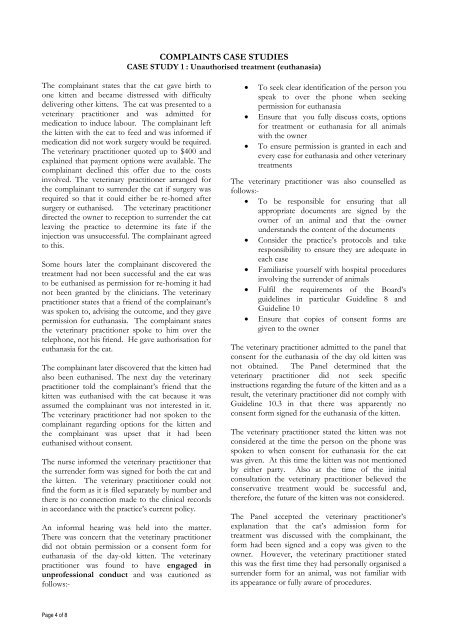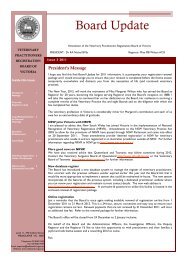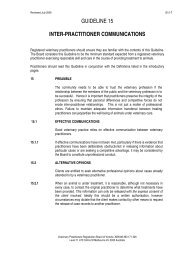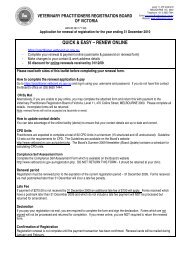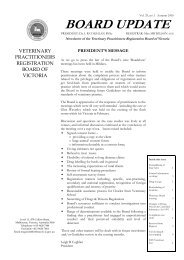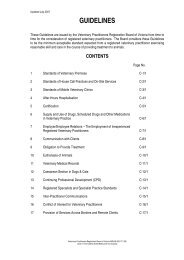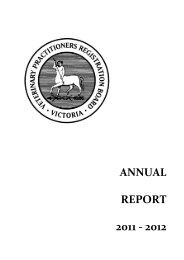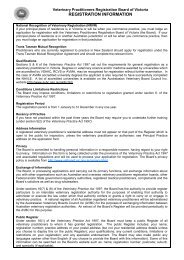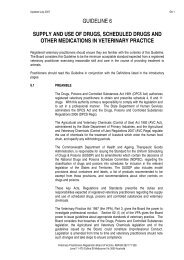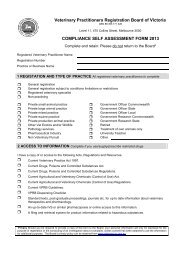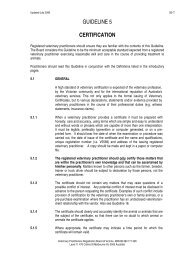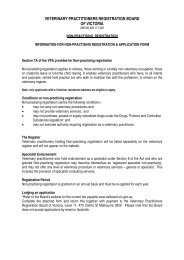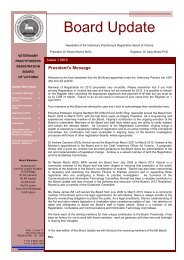board update - Veterinary Practitioners Registration Board of Victoria
board update - Veterinary Practitioners Registration Board of Victoria
board update - Veterinary Practitioners Registration Board of Victoria
Create successful ePaper yourself
Turn your PDF publications into a flip-book with our unique Google optimized e-Paper software.
COMPLAINTS CASE STUDIES<br />
CASE STUDY 1 : Unauthorised treatment (euthanasia)<br />
The complainant states that the cat gave birth to<br />
one kitten and became distressed with difficulty<br />
delivering other kittens. The cat was presented to a<br />
veterinary practitioner and was admitted for<br />
medication to induce labour. The complainant left<br />
the kitten with the cat to feed and was informed if<br />
medication did not work surgery would be required.<br />
The veterinary practitioner quoted up to $400 and<br />
explained that payment options were available. The<br />
complainant declined this <strong>of</strong>fer due to the costs<br />
involved. The veterinary practitioner arranged for<br />
the complainant to surrender the cat if surgery was<br />
required so that it could either be re-homed after<br />
surgery or euthanised. The veterinary practitioner<br />
directed the owner to reception to surrender the cat<br />
leaving the practice to determine its fate if the<br />
injection was unsuccessful. The complainant agreed<br />
to this.<br />
Some hours later the complainant discovered the<br />
treatment had not been successful and the cat was<br />
to be euthanised as permission for re-homing it had<br />
not been granted by the clinicians. The veterinary<br />
practitioner states that a friend <strong>of</strong> the complainant’s<br />
was spoken to, advising the outcome, and they gave<br />
permission for euthanasia. The complainant states<br />
the veterinary practitioner spoke to him over the<br />
telephone, not his friend. He gave authorisation for<br />
euthanasia for the cat.<br />
The complainant later discovered that the kitten had<br />
also been euthanised. The next day the veterinary<br />
practitioner told the complainant’s friend that the<br />
kitten was euthanised with the cat because it was<br />
assumed the complainant was not interested in it.<br />
The veterinary practitioner had not spoken to the<br />
complainant regarding options for the kitten and<br />
the complainant was upset that it had been<br />
euthanised without consent.<br />
The nurse informed the veterinary practitioner that<br />
the surrender form was signed for both the cat and<br />
the kitten. The veterinary practitioner could not<br />
find the form as it is filed separately by number and<br />
there is no connection made to the clinical records<br />
in accordance with the practice’s current policy.<br />
An informal hearing was held into the matter.<br />
There was concern that the veterinary practitioner<br />
did not obtain permission or a consent form for<br />
euthanasia <strong>of</strong> the day-old kitten. The veterinary<br />
practitioner was found to have engaged in<br />
unpr<strong>of</strong>essional conduct and was cautioned as<br />
follows:-<br />
• To seek clear identification <strong>of</strong> the person you<br />
speak to over the phone when seeking<br />
permission for euthanasia<br />
• Ensure that you fully discuss costs, options<br />
for treatment or euthanasia for all animals<br />
with the owner<br />
• To ensure permission is granted in each and<br />
every case for euthanasia and other veterinary<br />
treatments<br />
The veterinary practitioner was also counselled as<br />
follows:-<br />
• To be responsible for ensuring that all<br />
appropriate documents are signed by the<br />
owner <strong>of</strong> an animal and that the owner<br />
understands the content <strong>of</strong> the documents<br />
• Consider the practice’s protocols and take<br />
responsibility to ensure they are adequate in<br />
each case<br />
• Familiarise yourself with hospital procedures<br />
involving the surrender <strong>of</strong> animals<br />
• Fulfil the requirements <strong>of</strong> the <strong>Board</strong>’s<br />
guidelines in particular Guideline 8 and<br />
Guideline 10<br />
• Ensure that copies <strong>of</strong> consent forms are<br />
given to the owner<br />
The veterinary practitioner admitted to the panel that<br />
consent for the euthanasia <strong>of</strong> the day old kitten was<br />
not obtained. The Panel determined that the<br />
veterinary practitioner did not seek specific<br />
instructions regarding the future <strong>of</strong> the kitten and as a<br />
result, the veterinary practitioner did not comply with<br />
Guideline 10.3 in that there was apparently no<br />
consent form signed for the euthanasia <strong>of</strong> the kitten.<br />
The veterinary practitioner stated the kitten was not<br />
considered at the time the person on the phone was<br />
spoken to when consent for euthanasia for the cat<br />
was given. At this time the kitten was not mentioned<br />
by either party. Also at the time <strong>of</strong> the initial<br />
consultation the veterinary practitioner believed the<br />
conservative treatment would be successful and,<br />
therefore, the future <strong>of</strong> the kitten was not considered.<br />
The Panel accepted the veterinary practitioner’s<br />
explanation that the cat’s admission form for<br />
treatment was discussed with the complainant, the<br />
form had been signed and a copy was given to the<br />
owner. However, the veterinary practitioner stated<br />
this was the first time they had personally organised a<br />
surrender form for an animal, was not familiar with<br />
its appearance or fully aware <strong>of</strong> procedures.<br />
Page 4 <strong>of</strong> 8


